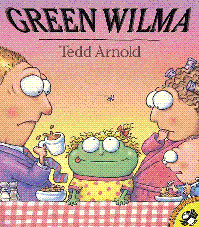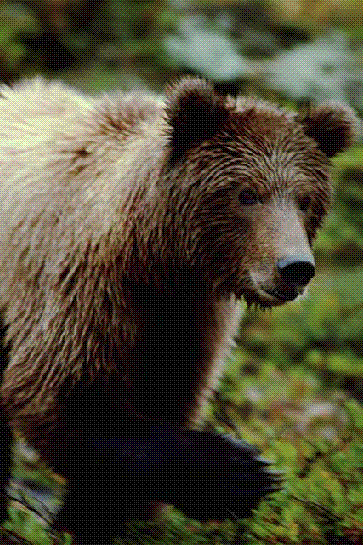Curriculum Continued
Introduction: Use the following poem about frogs to introduce the charming picture book, Green Wilma by Tedd Arnold, Dial Books for Young Readers, 1993. The story is about a little girl who wakes up green and has a strong desire to eat flies. The delightful twist at the end caught me by surprise.
Frog By Mary Ann Hoberman
Pollywiggle
Pollywog
Tadpole
Bullfrog
Leaps on
Long legs
Jug-o-rum
Jelly eggs
Sticky tongue
Trick flies
Spied by
Flicker eyes
Wet skin
Cold blood
Squats in
Mucky mud
Leaps on
Long legs
Jug-o-rum
Jelly eggs
Laid in
Wet bog . . .
Pollywiggle
Pollywog
From Mary Ann Hoberman's The Llama Who Had No Pajama: 100 Favorite Poems, Browndeer Press - Harcourt Brace & Company, 1998.
Extension: The ending to the accompanying picture book would probably need to be explained to little children, but they will delight in the illustrations and story of Green Wilma. Ask the children if they have ever dreamed they were someone or something else.


Introduction: The following poem can be used with a study on bears. The nonfiction book I've chosen is one of a series of six books about bears: Alaskan Brown Bears by Stuart A. Kallen, ABDO & Daughters, 1998.
Bear By Mary Ann Hoberman
I like to watch the big bear walk
When I go to the zoo;
Sometimes
Four feet
Seem
Two
Too
Much
And up he goes on two.
Then after he has strolled about
And roared an awful roar,
Sometimes
Two feet
Seem
Two
Too
Few
And down he goes on four.
From Mary Ann Hoberman's The Llama Who Had No Pajama: 100 Favorite Poems, Browndeer Press - Harcourt Brace & Company, 1998.
Extension: Show a teddy bear to the children and ask them if a brown bear (or any bear) would make a good pet, and why not? Discuss safety issues if encountering a bear in the wild.


Home